Nagano 3 Day Itinerary | FAQs | Trip Planning Guide

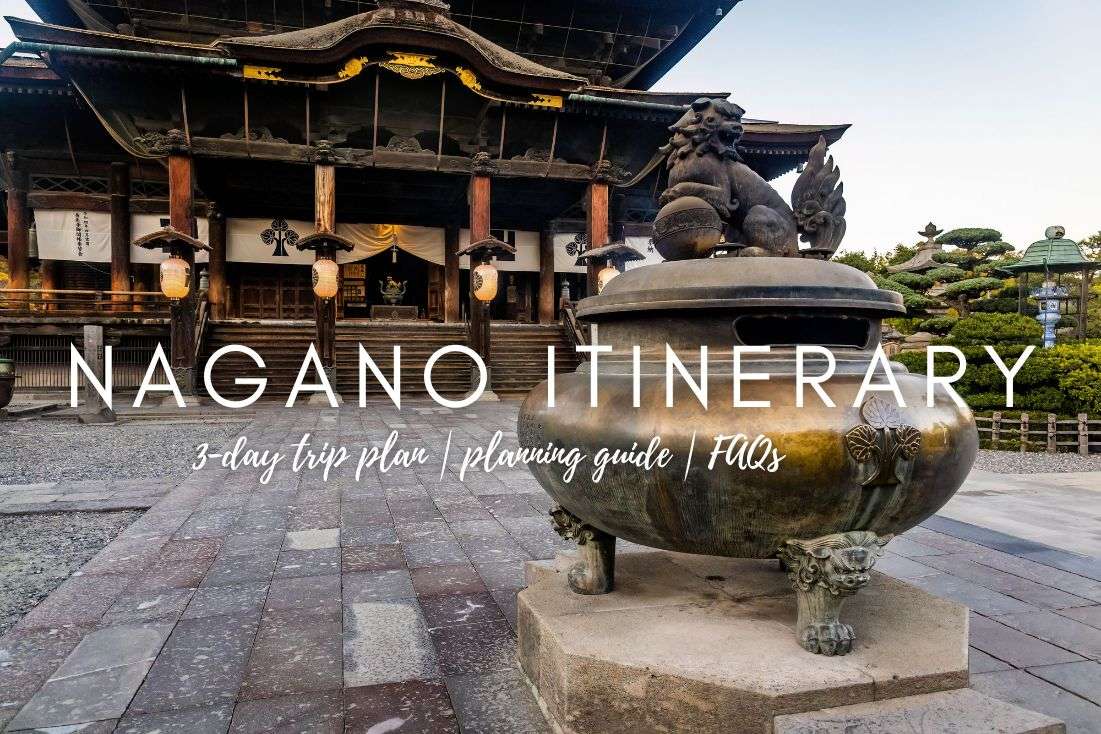
I'll take you on a three-day escapade through Nagano Prefecture, and don't worry, we won't just stick to the city—far from it! With Nagano’s nature being outrageously good, ignoring it would be criminal. Nagano shot up my list of top spots in Japan as fast as a bullet train, coming up just slightly behind Nikko in wow factor.
This Nagano itinerary isn’t just a list of cool spots to visit; it’s a full-on practical guide complete with travel times, eateries that don’t suck, and a no-nonsense approach, because I hate blogs that waste my time. My goal is to give you an itinerary that you can just pull up and follow from start to finish without any annoying extra research and getting lost between point A and point B, or arriving at point C famished with nowhere to have lunch.
I’ve vetted these places personally, so I'm only sending you to spots worth your time. Plus, expect some FAQs at the end of this itinerary to smooth out your planning wrinkles.
Do you want to see other places in Japan? You can find more articles about my experiences in the Japan section.
Each day is packed with activities, so starting early is crucial to making the most of your time in Nagano. Driving your own rental car allows for flexibility and the ability to cover more ground in this expansive and scenic region. Japan’s trains are great, but your own car is your own car (with your own trunk to keep all your junk—a serious bonus!).
Get your comfy shoes and camera ready—it's going to be a memorable journey!
Overview of your 3 days in Nagano

Ready to be amazed in Nagano Prefecture? It’s 3 days of non-stop wow
This itinerary includes these tourist spots and nature destinations within the Nagano Prefecture:
Day 1: Kiyotsu Gorge, Jigokudani Snow Monkey Park, Zenko-ji
Day 2: Kamikochi Valley, Tsumago–Magome walk
Day 3: Togakushi Shrines, Kagamiike Pond, Matsumoto Castle, Daio Wasabi Farm
Three days is just enough time to cover all the highlights in Nagano—get ready for some packed days!
The only thing I found underwhelming was the hotel situation—is it just me or are all the hotels in Nagano unimpressive?? Hotel Metropolitan Nagano isn’t going to win any awards, but at least it has location. Consider hotels in nearby towns, like Onyado Nono Matsumoto Natural Hot Spring, which at least has a hot spring on the premises.
If you want something with more amenities and a higher standard, you’ll have to hit to mountain resorts, like Holiday Inn Resort Shinano-Omachi Kuroyon. You’ll extend the already pretty long driving times that way, though.
Otherwise, there are tons of chalets and villas available for rent around Nagano, and if that’s something that appeals to you, the selection is wide.
Day 1 of Nagano itinerary: Gorges, monkeys, and temples
Here's the route all planned out for you on Google Maps (I’ve started it at Nagano Station, so exchange that for your hotel before you start and you’re golden)
Main sites visited on day 1: Kiyotsu Gorge, Jigokudani Monkey Park, Zenko-ji
Restaurant tips: the Fujiya Gohonjin (must try!)
Hotel recommendations: Hotel Metropolitan Nagano
Further reading: 10 Top Tourist Spots in Nagano
Day 1, stop 1: Kiyotsu Gorge
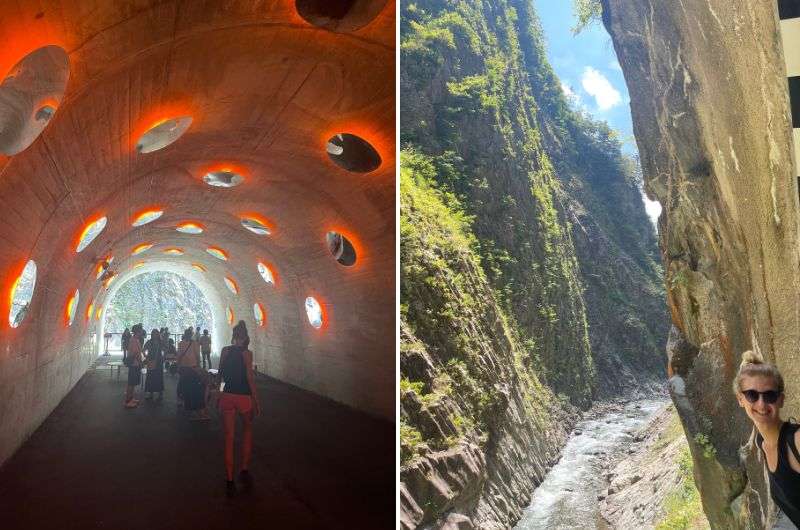
You go through the very unnatural Tunnel of Light to get amazing views of the natural beauty of Kiyotsu Gorge
Distance from Nagano: 86 km (53 mi), a 2-hour drive
Time spent here: 1.5 hours
Tip: Get there early to secure a good parking spot.
The first stop on your Nagano itinerary is in the opposite direction to every other spot you’ll be going to, so let’s get it out of the way first. Not that it sucks or anything, it most certainly doesn’t, it’s just a little annoying to have to drive all the way out there and then back again.
Go early in the morning because everyone and their dog visits Kiyotsu Gorge, and while parking is available, it definitely favors early birds. We arrived too late to park at the lots closest to the gorge and had to hop on a 20-minute shuttle bus to get to the entrance from where our car had to wait for us. Be smarter, wake up early!
You’ll drive about 2 hours from central Nagano, and then boom! It quickly becomes obvious that you aren’t in Europe anymore when you see that to enjoy Kiyotsu Gorge, there are no walkways or stairs, but a full-blown tunnel funhouse.
Dubbed the Tunnel of Light, is not just a path; it’s an experience. The tunnel runs 750 m (0.5 mi) along the gorge wall and offers various viewing points—every window frames nature like it’s curated art. Pretty clever, actually. The tunnel itself if full of artsy things to look at.
There’s a pool of water at the end of the tunnel that all the kids (and I) very passionately enjoyed. You can apparently get some very cool photos looking out from the tunnel at that end with a mirror effect in the water... but I did too much splashing around to remember to do that.
Kiyotsu Gorge gets busy, and it makes sense to make reservations, especially in the peak summer months. You get a 1.5-hour time slot which guarantees you entrance if you get your ticket in advance.
- Kiyotsu Gorge official website
- Open daily 8:30 am–5 pm
- Tickets cost JPY 1000, advance online purchase is recommended in the summer
Spend around 1.5 hours here and then hop back in your car (or the shuttle bus for you slowpokes). I see monkeys in your future!
Day 1, stop 2: Jigokudani Snow Monkey Park

They aren’t in the water very much, but you certainly see a lot of monkeys hanging out around the onsen at Jigokudani Monkey Park
Distance from last stop: 76 km (47 mi), a 1.5-hour drive
Time spent here: 1 hour
Tip: The park is best visited in winter for the iconic images of monkeys in the onsen, but it’s a fun experience year-round.
Next stop, Jigokudani Snow Monkey Park! About 1.5 hour’s drive back to Nagano from the gorge, this place is where you trade serene views for cheeky Japanese macaques lounging in hot springs. Or not—they only like going in the water in the winters, so in the summer, park attendants put treats in the water for them to coerce the snow monkeys to climb in. They never seem to stay very long though, preferring to snack and go. You’ll still see plenty of them lounging around on dry ground though.
Park your car at the bus stop close to the monkey park and walk 20 minutes into the wild side, erm, I mean though the forest to Jigokudani Park. Pay up JPY 800 and in you go. Then just hang out—watch the monkey antics, have a laugh, and snap some photos of these furry celebrities in their (almost) natural element. They are used to the human attention, so although you’ll see monkeys elsewhere on your trip to Japan, these guys in Jigokudani are definitely show-offs. And they have lots of babies!
Check out the online monkey cam to see what’s happening before you go if you can’t contain your excitement.
- Open daily 8:30 am–5 pm (closes an hour earlier in the winter)
- Tickets cost JPY 800
Day 1, stop 3: Zenko-ji Temple

IRL, the buildings at Zenko-ji are even more impressive. The main hall and the gate are absolutely massive!
Distance from last stop: 34 km (21 mi), a 1-hour drive
Time spent here: 1–2 hours
Tip: Check out the underground passage in the main hall, where you can experience total darkness and hope to find your way into paradise.
End your day at Zenko-ji, a temple that predates the city of Nagano itself. This massive wooden structure is not just a religious site but also a piece of living history, and its approach is lined with charming shops and eateries. It’s also the reason Nagano even exists, because the city evolved around temple and is now listed on Japan’s list of National Treasures.
Give Zenko-ji a good 1–2 hours, explore the grandiose main hall, the museum, and if you’re feeling adventurous, the underground passage in complete darkness is a must.
I actually considered skipping Zenko-ji, but boy am I glad I didn’t—it’s massive, and with a mountainous backdrop, totally stunning. You’ll understand why I’d think to leave it out of my itinerary once you spend some time in Japan. Temple burnout sets in pretty quickly. All the shrines and temples are lovely, but after the first 5, it takes something special to keep your interest up.
Parking at Zenko-ji is simple with plenty of small parking lots nearby. The going rate seems to be around JPY 100 for 30 minutes. Alternatively, if you’re staying in a centrally located hotel (like the admittedly-hideous-from-the-outside-but-nice-on-the-inside Hotel Metropolitan Nagano), you could just drop off your car at your accommodation and just walk to Zenko-ji—your dinner spot is very close to the temple, so it would make sense.

Lots of photo ops at Zenko-ji
Zenko-ji Temple houses one important, top-secret item: the first Buddhist statue ever to be brought into Japan. The statue is so special that nobody’s ever seen it… the thing has been hidden away since they found it and built a temple for it due to the temple’s secrecy commandment! Somehow though, there is a replica of it that gets shown every 6 years to crowds of pilgrims and tourists alike during an event called Gokaicho. Your next chance is in 2028.
The Main Hall at Zenko-ji has one peculiar addition to the many, many Buddha statues inside it—an underground passage where people walk in complete darkness trying to touch the “key to paradise” that hangs on one of the walls. Sadly, I am still here on Earth, so I at least had a lion’s portion of black eggs at Owakudani to make up for it and hope to live a very, very long, happy life.
- Zenko-ji official website
- The grounds are open 24/7, the museum and main hall are generally open from 9 am to 4 pm, check website for exact times
- Tickets: JPY 500 + JPY 600 for Main Hall
Dinner in Nagano on day 1

Fujiya Gohonjin has no competition in Nagano, and possibly in all of Japan. The. Best. Restaurant!
Right at the end of Zenkoji Nakamise Street is the best restaurant we encountered on our Japan trip: the Fujiya Gohonjin. Unlike many other places, it keeps up with the times—you can book a table online and order from their menu on a tablet. This spot's been serving up deliciousness since 1641, and let me tell you, the service is nothing short of top-notch.
For about USD 100 for two, my girlfriend and I indulged in wagyu steaks that were to die for (no clue what that is? You haven’t read my Japanese food guide, have you?). Another standout was the bagna cauda—a dipping sauce made with fish and served with veggies. It's easily one of the best meals I've had on my travels. You have the option to pick from an à la carte menu or dive into a tasting menu. Either way, you're in for a treat. Trust me, if there's one place you dine in Nagano, make it Fujia Gohonjin.
Day 2 of Nagano itinerary: Kamikochi Valley and some old Edo villages
Here are the stops of day 2 planned out for you on Google Maps. I hope you like driving!
Main sites visited on day 2: Kamikochi Valley, Tsumago to Magome Walk
Restaurant tips: Kamikochi Restaurant (for lunch) | the Fujiya Gohonjin | Sousake 28 | Takasa Sushi | the Source (Matsumoto)
Hotel recommendations: Holiday Inn Resort Shinano-Omachi Kuroyon
Further reading: Japanese Food Guide
Today you’ll see some beautiful nature in Kamikochi Valley and then take a journey to the past by visiting two Edo-period villages. It’s a long drive, so pack some snacks and good company and off you go.
Day 2, stop 1: Kamikochi Valley

You don’t need to climb mountains to see the beauty of Kamikochi Valley
Distance from Nagano: 100 km (62 mi), a 2-hour drive
Time spent here: 2–3 hours
Tip: Kamikochi always feels serene, but the bus tours tend to start piling in by mid-morning. The early bird catches the, um, emptier valley.
Early morning, hit the road to Kamikochi Valley. This place is a slice of paradise—a highland valley—about 2 hours from Nagano, with the drive just as picturesque as the destination. The air’s crisp, the river’s a stunning shade of turquoise, and the trails? They’re heaven for hikers and nature lovers alike. What are you waiting for?!
You’ll need to leave your car at the Sawando parking lot or the Hirayu parking area and then take a 20-minute bus to the national park from there—no cars area allowed in Kamikochi, adding to the serene vibes. Parking costs JPY 700 per day, the bus is around JPY 1,200 each way. There’s no entrance fee for Kamikochi Valley.
You could spend all day (and even a few nights) hiking up and down and all around, but that’s not what we’re doing today—actually, that’s what I never do. Day hikes all the way! Today you’ll stay low to the ground and take a nice walk along Azusa River instead.
There are quite a few trails, many of them interconnected, so you can head off and wander mindlessly and see where the universe takes you, or, use my advice on the best parts. Remember, you still have another stop on the itinerary today, plus a lot of driving, so aim to spend about 2 hours in Kamikochi Valley.
You could start your easy-breezy walk at Taisho Pond—right where the bus drops you off—and meander along the solid trails and boardwalks all the way to Kappa Bridge. It’s a tidy 3.5 km (that’s just over 2 miles for the metrically challenged) and crossing the river at Kappa gives you a perfect excuse to catch the bus back. Seriously, even if you drag your feet, you’ll wrap this up in under an hour.
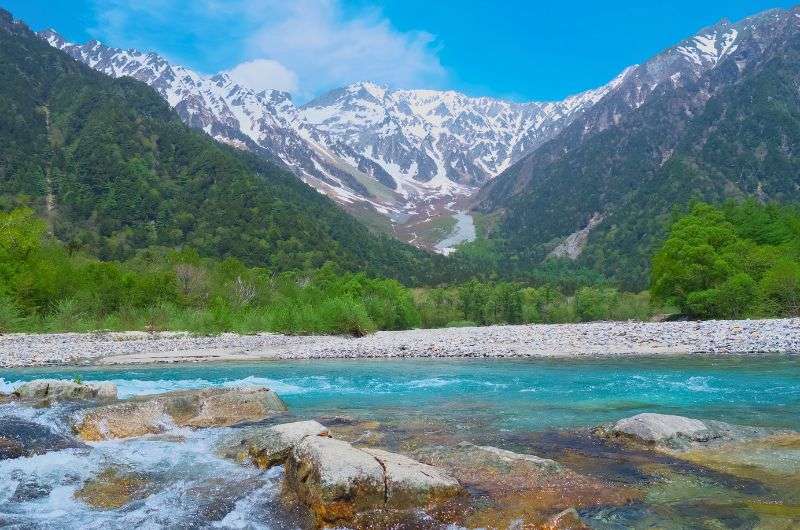
Kamikochi’s got you covered if you need a new background for your laptop
Feeling a tad more adventurous? Then why not take the route from Kappa Bridge to Myojin Bridge? The crowds thin out quickly as you head out 3.5 km to Myojin, where you can cross over and come back via the slightly shorter south route. It’s a scenic round trip that you can easily do in about 1.5 hours. And if you fancy saving the best views for last, start from the south and make the northern stretch your grand finale.
If you can’t decide between the two, link them up or pick a side trail—Kamikochi is forgiving enough to cater to your whims.
Note: If you’re up for more of a challenge, read up on the Yakedake trail. Mt. Yake is an active volcano that is super fun to climb, but it takes 6 hours total and since there are only so many hours in a day, you’d have to skip the Edo villages.
Lunchtime!
Before you head back to your car, you’ll want to refuel—there’s a restaurant with average food but nice views right in the park. Kamikochi Restaurant is on the second floor of the Kamikochi bus stop and gets the job done. Beware that it can be full of tour groups around noon, so you’d better go sooner rather than later.
Otherwise, just put the pedal to the metal and head 45 minutes away to a town called Kiso. There are many restaurants there.
Day 2, stop 2: Tsumago to Magome Walk
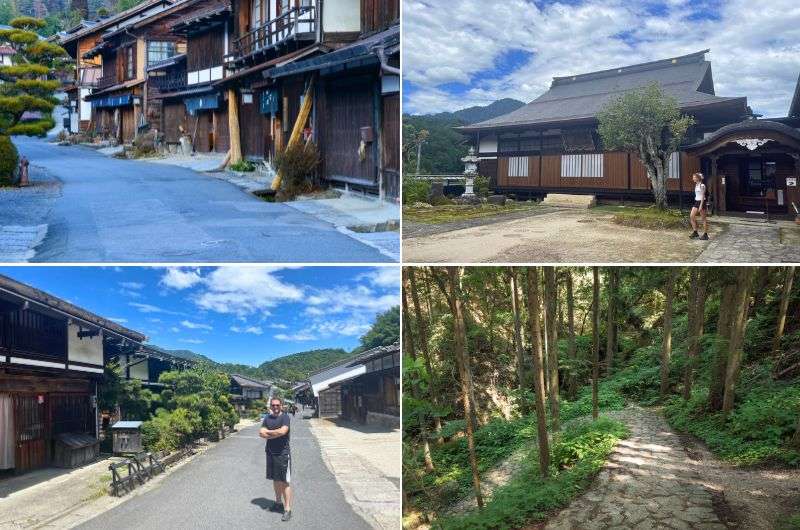
A 2–3 hour trip down Japanese memory lane (the walk between Tsumago and Magome)
Distance from last stop: 90 km (56 mi), a 2-hour drive
Time spent here: 2–3 hours
Tip: Start at Tsumago, walk to Magome, and take a bus or taxi back to your starting point.
After Kamikochi, take a drive to Tsumago village, about 2 hours away, to start the famous Tsumago-Magome walk. You'll have to park your car on the outskirts for a measly JPY 500, but it’s worth it to keep these spots pristine and authentic.
This 7.5 km (4.6 mi) hike is like wandering through a live-action museum set in the Edo era, which was all about samurais and secluded culture thanks to Japan’s closed-off policy back then.
Once you’ve talked to the locals (hello to the cool old man I took a photo with!), start on the trail linking Tsumago and Magome. It runs along the old Nakasendo road, which used to connect Kyoto and Tokyo back in the day. The hike isn’t too tough, mostly just a gentle climb through some gorgeous scenery, past a couple of waterfalls, rice paddies, shrines, and right alongside traditional houses.
If you find yourself dreaming about exploring inside some of the old houses on the way, you’re in luck! About halfway is the Tateba Tea House—a traditional house serving free hot tea to tourists. You are welcome inside for a drink and a look. Donations are welcome. Don’t expect any food, aside from when the owner randomly brings out snacks or pickles, but there’s no guarantee.
It’s an easy trek, peppered with the charm of rural Japan, and a stark contrast to the mountainous morning at Kamikochi. It took us about two hours to hit Magome and then we just bussed it back to Tsumago. If you’re on the slower side, it could take up to 3 hours, so plan your time accordingly. Oh, and pack a bear bell—turns out there’s more wildlife here than just the friendly locals.
The only downside of this little stop on your Nagano itinerary is that it’s far away from everything, so prepare for a 3-hour drive back to your hotel. If you’ve chosen one of the hotels in Matsumoto, like the superb Onyado Nono Matsumoto Natural Hot Spring (yes, it has it’s own hot spring!), you’re only looking at 2 hours in the car.
Dinner time in Nagano
You must be hungry after all that walking and driving! If you make it back to Nagano just in time for dinner, I can recommend Sousake 28, a soba restaurant with intimate lighting and a very talented chef.
If you’re craving sushi, head to Takasa Sushi. Think quaint, tatami-style restaurant with friendly service and no English menu. Good luck!
And if you stayed out too late and the rumbling in your stomach is too much to take, make a stop in this Matsumoto restaurant on your way back to Nagano: the Source is a diner. It’s a small, friendly place that I can only describe as a burger joint with a Japanese twist.
Day 3 of Nagano itinerary: Togakushi and Matsumoto
The final day of this Nagano itinerary planned out for you on Google Maps
Main sites visited on day 3: Togakushi Shrines, Kagamiike Pond, Matsumoto Castle, Daio Wasabi Farm
Restaurant tips: restaurant at Kagamiike Lake (for lunch) | the Source (Matsumoto)
Hotel recommendations: Holiday Inn Resort Shinano-Omachi Kuroyon
If you like leaving the best for last, you’re in luck today! We’ll finish off your itinerary with my favorite spot not just in the Nagano prefecture, but in all of Japan—Togakushi Shrine. And just when you thought it couldn’t get any better, we’re heading to Matsumoto Castle to cap off the day. Trust me, it's the perfect grand finale to 3 days of epic sightseeing in Nagano! Make sure to get an early start.
Day 3, stop 1: Togakushi Shrines
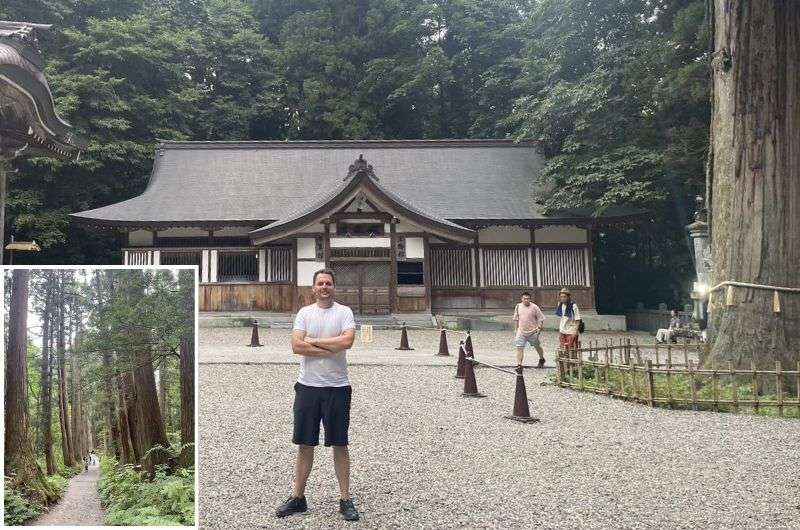
The Togakushi 5 Shrines hike was my favorite thing to do in all of Japan. Don’t miss it
Distance from Nagano: 20 km (13 mi), a 30-minute drive
Time spent here: 4 hours
Tip: Wear comfortable shoes as the trails include some steep sections and stairs.
Day three, and it’s a spiritual start at Togakushi Shrines—there’s a phenomenal trail linking all 5 of them! The parking’s straightforward (we parked at the main shrine, Okusha), and from there, you're in for about 3 hours of hiking through a mystical cedar forest. It’s steeped in mythology and bursting with natural beauty.
Spoiler! There’s a super fun Ninja Museum and lots of restaurants around that make the Togakushi Shrines one of the best places to visit in Nagano.
The Togakushi shrines are scattered across three different levels on the mountain and are tied to a captivating piece of Japanese mythology. The tale involves the Sun Goddess Amaterasu, who retreated into a cave, shrouding the world in darkness after being upset by her brother's actions. To coax her out, the other deities performed a dance outside the cave. Once she emerged, a deity quickly threw the cave door away to prevent her from secluding herself again. This thrown door is believed to have landed at Togakushi Mountain, giving the area its name, which literally means "hiding door." Each shrine is dedicated to one of the deities involved in this myth.

Who says ninja obstacle courses are for kids?!
The Togakushi 5 shrine trail is a solid 5 km (3 mi) trek that'll take you about 3 hours if you're not dilly-dallying. The trail is split into three tiers: there are the lower shrines, Hokosha and Hinomikosha, work Chusha in the middle, and then Kuzuryusha and Okusha, the main shrine at the top.
Once you've parked near Okusha, your first stop should be the Folk Museum. It’s as touristy as it sounds, but trust me, it’s worth it. You'll learn about rural life and see some silk displays that might impress your grandma. The real gem, though, is the Ninja Fun House—think of it as the Japanese version of an escape room, but less claustrophobic and more historically confusing. It’s fun, and it's about 30 minutes of trying to get through the tricks and traps (that my girlfriend kept reliving for the entire rest of our Japan trip).
After that, a side trail (or a short drive) leads you to Kagamiike Lake, which we’ll talk about next. You’ll want to allow at least 3 hours for the 5 shrines hike. Add 1 hour for the Ninja and Folk Museums.
Museum tickets: JPY 650. There’s no entrance fee for the shrine trail.
Day 3, stop 2: Kagamiike Lake

Although you can drive to Kagamiike Lake, the trail is half the fun!
Distance from last stop: the hike starts at Okusha shrine (the last stop)
Time spent here: 1.5–2 hours
Tip: If you’re short on time or stamina, you can drive to the lake instead of walking the trail.
When you’re at Okusha main shrine, notice a side trail leading to Kagamiike Lake. This little gem offers reflective views of the Togakushi range, and if you catch it on a clear day, the photos are postcard-perfect. But, if you’re like us and catch a cloudier day, don’t fret. It’s still pretty! Maybe just check the weather beforehand if you’re flexible which day you can visit.
Kagamiike Lake trail is a two-hour hike that’s very pretty and a lot less crowded than the Togakushi Shrine main trail. The scenery could fool you into thinking you've stumbled into Northern Thailand or Vietnam, except, you know, you’re in Japan. Theoretically, you could nail this hike in under two hours, but let's just say we took the scenic route... very scenic, thanks to some less-than-obvious trail markers and a completely absent internet connection. Pro tip: Learn the Japanese name for Kagamiike just to avoid the scenic route we took. It was nice, but not that nice.
For those lucky enough to catch Kagamiike on a cloudless day, the lake mirrors the sky and mountains in a way that’s downright criminal in its beauty. We, sadly, were not those lucky few.
A note on timing: You still have 2 stops ahead of you and they both close at 5 pm, so if time is of the essence and you really want to see everything, you probably can’t do the Kagamiike lake trail. Drive there instead to save time, or skip the wasabi farm at the end. Up to you.
Lunch break!
If you can get there without getting lost, there's a cabin-like restaurant at the lake’s edge that lets you eat with a view. We skipped because, well, we were too busy getting un-lost. But you should definitely stop; rumor has it, the coffee and galette taste better when you're not tasting your own defeat.
Day 3, stop 3: Matsumoto Castle
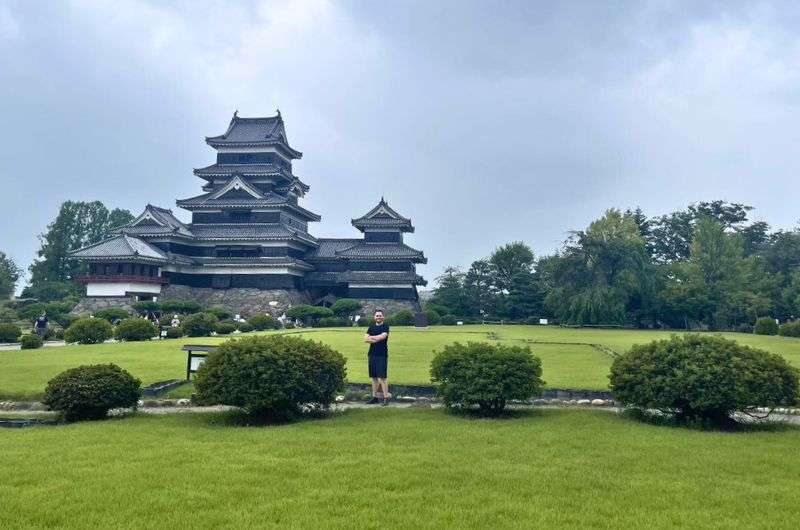
Playing it cool in front of Matsumoto Castle, all the while my inner ninja child is screaming with joy
Distance from last stop: 117 km (72 mi), a 1.5-hour drive
Time spent here: 1.5 hours
Tip: Don’t miss exploring the hidden floor designed for protection during sieges.
Next, book it down to Matsumoto Castle, about 1.5 hours away. This black-and-white structure is a feudal fortress that’s stood the test of time by being awesome! Just kidding. The top tipping to one side needed to be fixed precisely because it did not withstand the test of time (or was it that curse?). But it sure is awesome! If you can empathize with my love for anything ninja, you’ll love Matsumoto just I like did. It's exactly the kind of Japanese castle you dream about when you’re a kid fighting off evil with your mom’s spatulas.
With parking close by, you pay JPY 700 to enter and step back in time into one of Japan’s premier historic castles. Your approach to the castle will take you across a moat filled with oversized koi that add to the dramatic setting. Local legend has it that Matsumoto Castle leans slightly due to a curse from Tada Kasuke, a farmer who led a tax rebellion and was executed, who now supposedly tries to topple the castle from beyond the grave.

Nice castle...
Once inside, prepare to remove your shoes. Remember to wear some thick socks because those ancient wooden floors can be quite chilly! The main draw inside the castle is the second floor, which houses an extensive collection focused on warfare and weaponry, complete with detailed how-to guides that explain everything from the construction of the castle walls to the use of arquebuses. You finish the visit by climbing 140 steps all the way to the top. The stairs are steep, so pace yourself.
Give it a solid 1.5 hours minimum and remember to try to catch a ninja demonstration! There are costumed employees in the gardens happy to take pics with tourists.
- Matsumoto official website
- Generally open daily from 8:30 am–5 pm
- Tickets cost JPY 700
Day 3, stop 4: Daio Wasabi Farm (optional because you may run out of time)
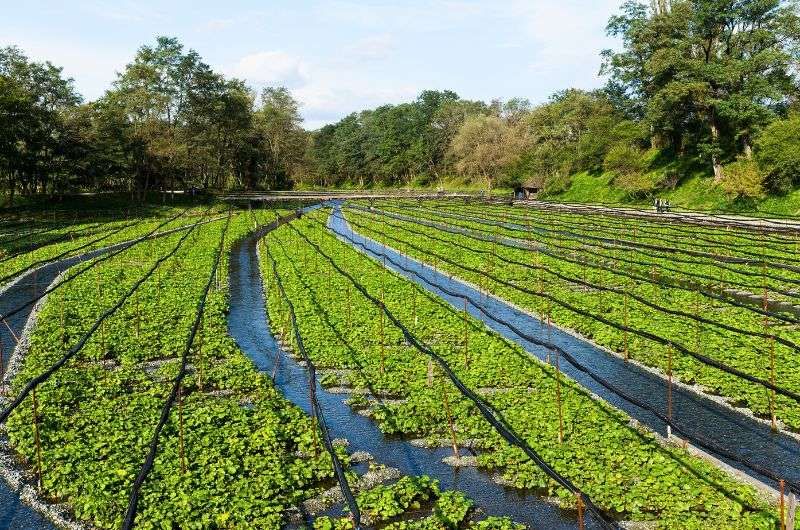
See? Bet you didn’t know wasabi grows like this!
Distance from last stop: 15 km (9.5 mi), a 25-minute drive
Time spent here: 1 hour
Tip: Skip the wasabi beer—not my favorite Nagano memory.
Wrap up your day at Daio Wasabi Farm, where you can learn about wasabi cultivation and try wasabi-flavored snacks. It’s a refreshing end to your three-day Nagano trip. This is when you can really tell if you started your day early enough. The Daio Wasabi Farm closes at 5 pm, so you may simply find that you’re leaving Matsumoto Castle and it’s 4:30 pm already, in which case, no wasabi ice cream for you.
Parking here is free, and there's no entry fee, so you can wander through Japan's largest wasabi farm at your leisure (but hurry up, I told you they close soon!). You can tour the farm on your own on two different routes—the red trail takes 45 minutes, the blue just 20 minutes. Check out the unique water growing methods and enjoy a bit of the local flavor with wasabi-infused goodies from the on-site cafes and stands. There is a boat tour available for a fee of JPY 1200, but, alas, we didn’t have enough time to go on it.
Daio Wasabi Farm is a spicy, educational finish to your epic three-day Nagano adventure, perfect for soaking up the serene farm atmosphere, complete with the Alps as your backdrop, before heading back to the hustle of Nagano city life. That is, unless your hotel is in Matsumoto, like the Onyado Nono Matsumoto Natural Hot Spring. Not having to drive an hour back to Nagano sounds great just about now, right?
- Open from 8 am–5 pm in spring to fall, closes at 4 pm in the winter
- Free entry, free parking

Summer in Nagano means cloudy skies, but who says cloudy skies are always a bad thing?
FAQ 1: When's the best time to visit Nagano?
Spring through fall is the best time to visit Nagano unless you’re after winter sports, in which case, why are you even asking? In spring, the landscapes wake up with flowers, and in the fall, the leaves put on a color show that's tough to beat... which is why I visited in the summer, haha. Summer is a good time to visit Nagano (and Japan as a whole) if you don’t mind the heat and cloudier skies.
FAQ 2: How many days do I need in Nagano?
Three days should cut it in Nagano. That's enough to hit the major tourist spots and natural highlights without feeling like you're in a rally race. Trust me, Nagano's not the place to rush through—its beauty deserves your time. Why people visit for a single day is beyond me. If you have limited time, skip Tokyo! It sucks.
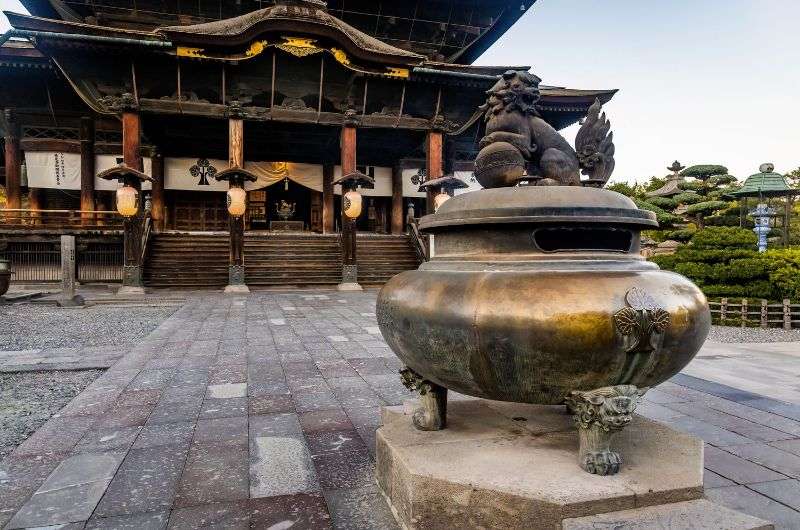
Zenko-ji Temple might be the main (and only) highlight of Nagano city, but it's an absolute gem that's well worth the visit
FAQ 3: Is Nagano city worth visiting?
Sure, especially for a stop at Zenko-ji Temple, but let’s be honest, the real action is in the wilds outside of Nagano city. So, hit the temple, then make tracks for the hills where the adventure is. The only other place that’s a must-visit inside of Nagano is the best restaurant we visited on our trip: the Fujiya Gohonjin.
FAQ 4: Do you need a car in Nagano?
Yes, because the vast majority of places you’ll want to see in Nagano aren’t in the city. Even with a car, you’ll spend hours getting to places; I can’t imagine trying to bus it. A car is essential: you go where you want, when you want, and that’s pretty much the dream in an area as spread out as Nagano.
FAQ 5: How to get to Nagano from Tokyo?
Take the Hokuriku Shinkansen from Tokyo; you'll be in Nagano in about an hour and a half. It’s fast, efficient, and is covered by the JR Pass. The train gets you from city bustle to mountain tranquility quicker than you can finish a podcast episode. Driving from Tokyo to Nagano will probably take double the time as the bullet train, so just rent a car once you get to your destination.

Visiting Nagano in the summer? Sure! That’s what ice cream is for! @Zenko-ji
FAQ 6: Is Nagano worth visiting in summer?
Oh, absolutely. I visited Nagano in the summer, so it has to be a good idea—I don’t have bad ones. Sure, you won’t catch the cherry blossoms in bloom, but who needs petals when you have clouds, right? And I mean a lot of clouds—like, peak cloud season! But look, if I survived the obscured views and still raved about the place, you’ll do just fine. Pack a sense of humor with your hiking boots and you'll have a blast.
FAQ 7: What are the 5 shrines in Togakushi?
The five Togakushi Shrines, which you should definitely not miss while visiting Nagano, are Hokosha, Hinomikosha, Chusha, Kuzuryusha, and Okusha. Each one has its own charm and is part of the Togakushi trail that’s a real treat for both your spirit and your calves.
This post contains affiliate links. I earn a small commission if you make bookings through my links, at no additional cost to you. Thank you for your support!


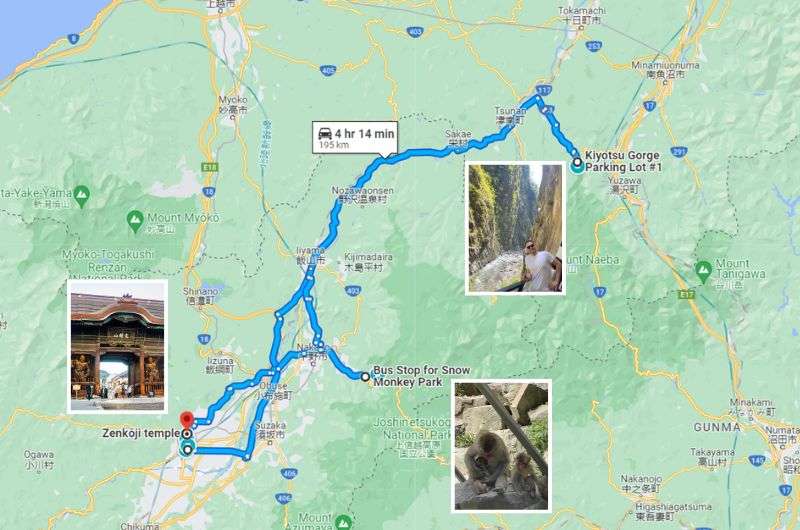
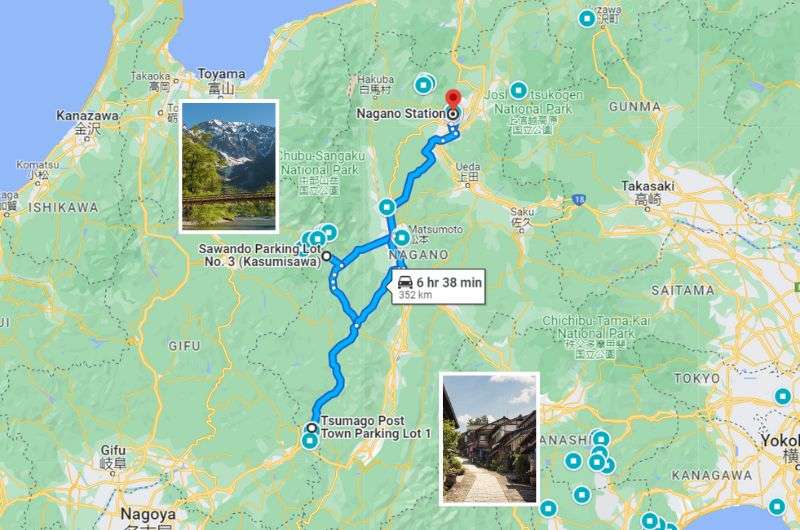

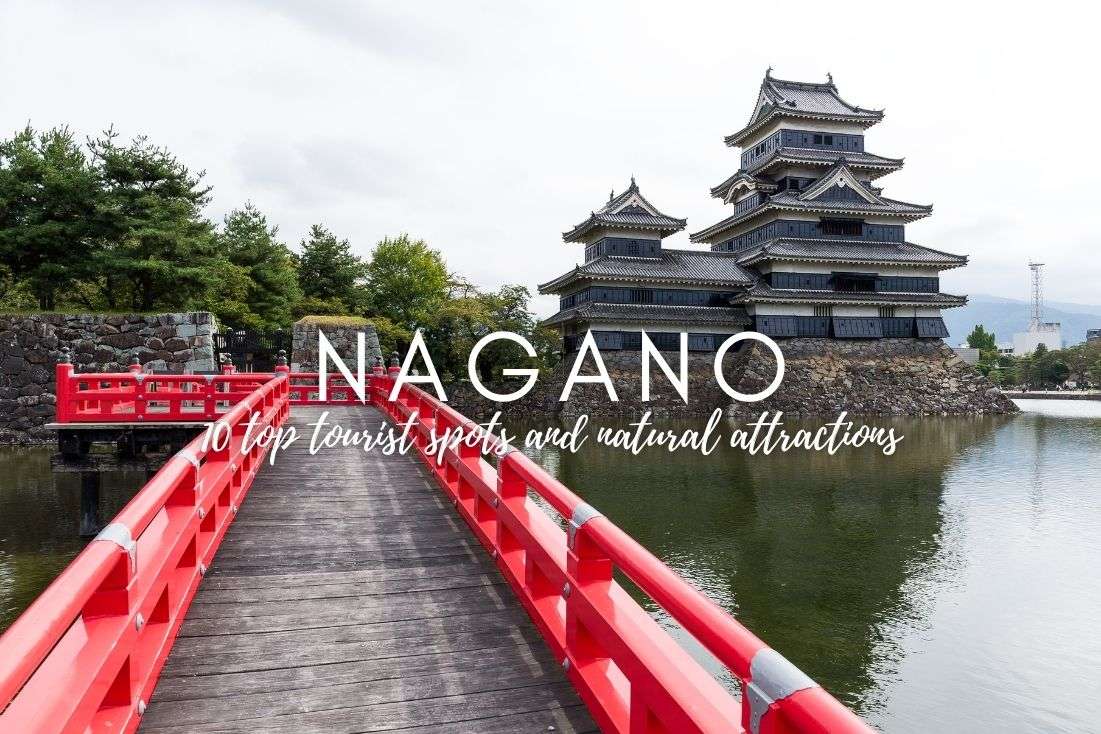
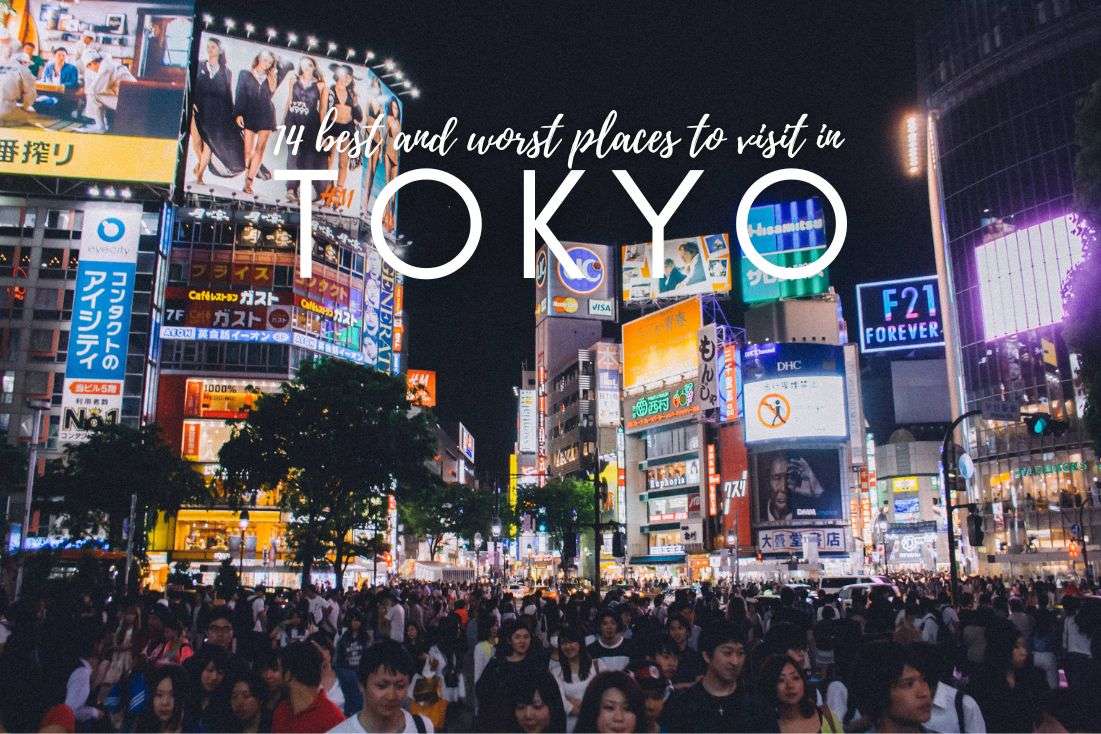






Comments | Thoughts? Give us a shout!